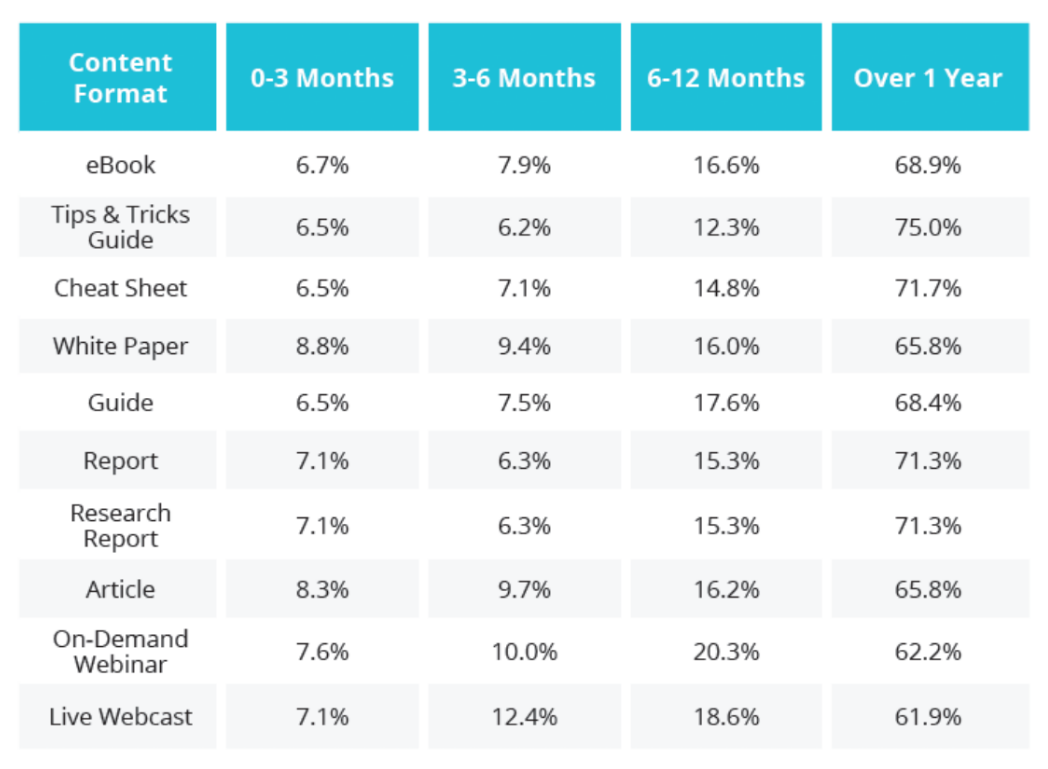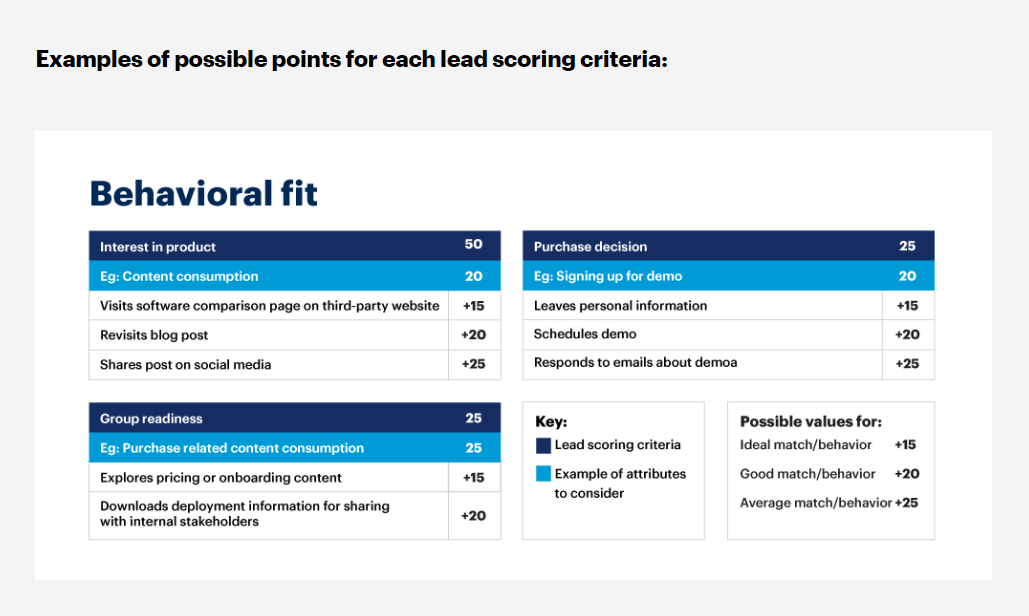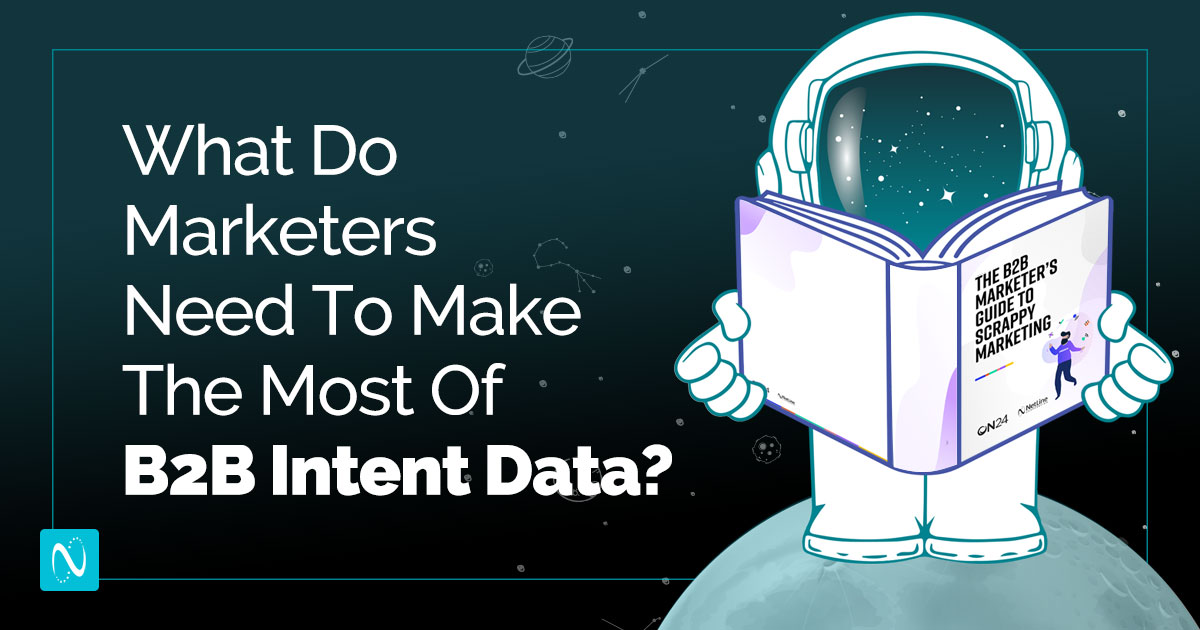As B2B marketing becomes more complex, high-quality, buyer-level, and validated intent data is necessary to drive success. But as B2B marketers start using intent data, what do they need to get the most out of it?
In this post, we will explore the essential skills, competencies, internal processes, technologies, and tools that B2B marketers need to deliver high-quality leads and impact pipeline using intent data.

The amount of B2B marketing data can be overwhelming, but with the right foundations, you can use intent data to its full potential.
The skills and competencies needed to get the most value out of intent data
B2B marketers are faced with what seems like an ever-changing landscape where buying cycles are longer and often more complicated. Added to that, is the preponderance of competition. Vendors are attempting to grab the attention of buyers who are choosing to do most of their research online before getting in touch with a vendor. Truly, they are the ones in control. And, while the number of marketing technologies out there meant to make their jobs easier is growing every year, data analysis has long been a much sought-after skill set.
Despite all this complexity, many B2B marketers have been able to get results—even when they feel their knowledge and understanding is at a basic level. It’s clear, though, that outsized results are possible for those that look to get ahead of others. So, with that in mind, what skills and competencies do marketers need to get the most out of intent data?
Understand what buyer intent data is and what it offers
First and foremost, it’s important for marketers to understand what buyer-level intent data is and how it works.
The definition of buyer-level intent or buyer intent data is “the measure of an individual prospect’s readiness to make a purchase within a given timeframe. This measurement is based on a group of signals presented by a prospect over the course of their digital journey.” Where it differs from company- or account-level intent data is it hones in on who is showing intent, giving you a human to target because, as we’ve said before, it’s humans that make decisions, not accounts.
Buyer-level intent data provides insights into what content a prospect is consuming and what sites they are visiting. A very valuable signal this sort of data provides goes beyond just what type of content a potential buyer is engaging with, but also the frequency in which they are engaging with it. These two elements can indicate when a prospect is ready to make a purchase.
For instance, our research found that the more content a prospect consumes the more likely they are to make a purchase decision within the next 12 months. Alongside that, as we shared in our 2022 B2B Content Consumption Report, white paper registrations are a greater indication that a user is in a late stage of a purchase decision.

The content format prospects consume is a strong indicator of buying intent. Source: NetLine’s How Buyer-Level Intent Data Reveals “Who” is Ready to Buy?
Data from our 2023 edition of the consumption report revealed that:
- Users registering for Live Webinars are 22.0% more likely to be correlated with a purchase decision within the next three months.
- Live Webinar sign-ups indicate a user’s proximity to a final purchase decision, On-Demand Webinar registrations should be setting off alarms within your Marketing department.
- Compared to other formats, On-Demand Webinar registrants are 50.0% more likely to make an investment within the next six months.
- While On-Demand Webinar registrations send an exceptionally strong intent signal,
Live Webinar registrations indicate a more immediate investment. - Head-to-head, Live Webinar registrants are 107.0% more likely than On-Demand Webinar registrants to make a purchase decision within three months or less.
Possess a data-driven and data-aware mindset
Taking full advantage of B2B intent data requires that B2B marketers and organizations, in general, develop a data-driven mindset. Embracing a data-driven approach and learning to analyze data will help you draw actionable insights from intent data and make informed decisions. Encouragingly, research from 2020, shows that nearly 70% of marketers were using data in their decision-making process at least most of the time.
Being data-driven also means that you are aware of the common issues that B2B buyer data has and that you also have an awareness of the limitations of the data in your company’s own systems. This can help to both avoid taking decisions or using data incorrectly, and to be proactive in addressing such issues.
In the case of intent data, potential limitations or issues can include:
- Data quality and accuracy issues, especially when using third-party intent data that is created through unknown (“black box”) methods.
- Data silos between different teams, systems and suppliers.
- Data decay as buyers change jobs, contact details, and preferences.
- Data privacy and security issues that could result in numerous issues, from annoyed prospects to serious legal and reputational damage.
- Data standardization and integration issues.
- Incomplete buyer and account profiles, leading to missed opportunities with sales and lower-quality buyer experiences.
Knowledge of how to use core B2B marketing technology
Having a data-driven mindset goes together with being proficient in the technologies that uncover and make use of that data. Mastering your CRM and marketing automation tools enables you to seamlessly integrate intent data into your workflows and campaigns.
Furthermore, being comfortable with technology allows you to be creative in making the most of your intent data—whether that’s in the form of orchestrating exciting new campaigns or thinking of new ways to empower your sales team to use intent data.
A positive and productive relationship with sales
A contributor to any successful B2B marketing strategy is alignment between sales and marketing. This holds true when getting the most value out of intent data. Collaborating with your sales team to align on lead qualification and scoring criteria is essential, as it informs marketers what signals to look for in the intent data and increases the likelihood that prospects will eventually convert.
Effective communication and storytelling with stakeholders
To be completely frank, none of these skills or competencies will matter if you don’t have buy-in from internal stakeholders. A way to get stakeholders on board is by using storytelling and persuasive communication to educate internal stakeholders about the value of using buyer-level intent data. Show them the benefits of using visualization tools, which we will discuss later.
The internal processes that should be in place to use intent data effectively
In addition to having a foundation of skills and competencies, your marketing team (and the wider revenue team) needs to have a baseline set of processes that determine the lead-to-revenue process in your company.
A clear and agreed definition of what makes a lead or account qualified
Alongside having buy-in from internal stakeholders, there are certain internal processes a B2B organization needs to have in place to use intent data to its fullest potential. One of the most important processes that must be in place is a smooth working relationship between sales and marketing.
We touched on this earlier, but it bears repeating: marketers need to collaborate with their sales team to establish a clear definition of a qualified lead. This is not something that marketing departments should define on their own. In an upcoming post, we’ll point out the various types and definitions of sales leads that exist, including how one organization’s sales team may define a lead can vary from another organization’s team.
Bringing marketing and sales together to nail down exactly what a qualified lead looks like to them can save time and resources later on. If this doesn’t happen, marketing won’t necessarily have a firm grasp on what signals they should be looking for in the intent data. What may seem like a lead that looks like they are prime to make a purchase to a marketer can be a dud in the eyes of an experienced salesperson. However, if marketers and sales align on what a quality lead looks like and what signals to look for, marketers can start to use intent data to identify leads that sales can convert.
Lead scoring and account qualification is in place to identify sales-ready buyers
Another process that needs to be in place to effectively use intent data is implementing a lead scoring system. HubSpot defines a lead scoring model as “the process of assigning values, often in the form of numerical “points,” to each lead you generate for the business.” While scoring is often based on criteria such as demographic criteria such as industry, company size, job title or company revenue, there are also behavioral criteria to consider.
It’s within the behavioral criteria that intent data comes into play, but first marketers must determine what behaviors a prospect should display to show purchase intent. This is why working with sales to define what a quality lead looks like is so important. Once that is determined, scoring can be assigned. A prospect displaying all or most of the behaviors mapped out in the scoring model will receive a higher score and be prioritized higher compared to a prospect displaying fewer of those behavioral signals.

Example of lead scoring points based on behavioral criteria. Source: Gartner.
Lead nurturing programs to warm up buyers and accounts that aren’t ready just yet
So, what about those prospects that, while showing some interest, aren’t scoring high enough to make you believe they are ready to purchase? Those are the leads that need a little more care and attention before they are ready to be handed over to sales.
This is why it’s so important that your organization develop a lead nurturing program.
Surprisingly, 2021 data from Ascend2 revealed that 45% of marketing professionals reported that their organization didn’t have a lead nurturing program. This is even though an overwhelming majority of respondents also agreed that allocating more time and resources to lead nurturing would improve conversion rates.
How does intent data fit into a lead nurturing program? Quite simply, buyer-level intent data tell you who your lead is. By knowing who they are and how they are progressing on their journey, you can reach out to them on a more personalized level, tailoring your messaging to address their needs and gently move them closer to a purchase decision.
As we have discussed in a previous post, one important trait marketers need for a successful lead nurturing program is patience. While marketers are eager to see leads progress through the buying journey, they must resist the urge to push too much on buyers that are showing intent.
For example, having sales approach a few minutes after a content download is more likely to irritate than delight. Instead of jumping on the phone or shooting off an email, give the lead about 48 hours to download, consume and digest what they’ve requested.
Closed-loop feedback to optimize results
Last but not least, to successfully use intent data make sure to create a closed-loop feedback process between marketing and sales. Because no strategy or campaign is perfect, you’ll want to continuously refine lead qualification and scoring criteria.
Having a system of ongoing collaboration and feedback between sales and marketing teams will drive continuous improvement and help you get the most out of your intent data.
The right technology and tools to make the most of intent data
There are plenty of technologies and tools out there that promise to help make the most of intent data. But how do you really know if it’s the tech that’s going to work for you?
Here is a rundown of a few things to look out for to choose the right intent data provider and make full use of it:
Choose a reputable intent data provider: This one practically goes without saying, but we will say it anyways. Of course, you want to deal with a reputable provider who isn’t going to disappear overnight and leave you hanging —or perhaps even worse, provide you with useless data. Research the solutions out there and make sure they offer buyer-level and validated data.
Choose a vendor matched to your marketing capabilities: As with all marketing technology investments, you will only get a return on your investment if you can get more value out of the product than what you put in. This means that if your organization is very small or only has basic marketing and sales processes, a complex enterprise-grade product is highly unlikely to be a good fit. At the other end of the spectrum, a low-cost vendor might not provide the features and functionality needed to drive results in more advanced organizations.
Evaluate integration capabilities of intent data providers with your existing technology stack: Integration of marketing and sales solutions, or lack thereof, continues to plague organizations. Unfortunately, full integration looks a long way off for many organizations, with a report from SharpSpring and Ascend2 that only 11% of marketers report that their technology stack is fully integrated into a single platform.
You want intent data to work for you and add to the data you already have, so you can get a complete picture of your buyers. So, it stands to reason that any intent data solution you choose should easily integrate with your existing stack to avoid having this valuable data in a silo.
In particular, take a careful look at exactly how any integration works. Many native integrations that vendors offer do not have the same data or functionality as offered by their core product. Also, they may only be useful “off the shelf” for organizations that have a particular set of sales and marketing processes.
Implement a data governance process to ensure the accuracy and privacy of intent data: While the term ‘data governance’ might sound complex, your approach doesn’t necessarily have to be. Google defines data governance as, “everything you do to ensure data is secure, private, accurate, available, and usable. It includes the actions people must take, the processes they must follow, and the technology that supports them throughout the data life cycle.”
The key terms to focus on here are accuracy and security. Simply put, intent data, or any data for that matter is worthless if it’s not accurate and complete. Alongside that, keeping your data secure not only keeps you in compliance with regulations such as GDPR and CCPA but it’s also just good practice. There is a growing concern about personal data and what companies are doing with it, so being responsible with your data makes good business sense.
Bonus tip: Many vendors make their data privacy certifications publicly available—for example, NetLine’s Privacy Shield Certification or Google’s List of Compliance Reports. Look to add these to any of your own documentation to demonstrate how your chosen vendors address data protection and privacy standards.
Use visualization tools to help analyze and interpret intent data insights effectively: There are some people who salivate when they are presented with a bunch of data points on a spreadsheet. They are magically able to pull out insights from the columns and rows of data. However, the rest of us mere mortals, need data to be presented in more easily consumable way, preferably in a nicely formatted graph or chart with colors and visual cues that make insights pop out.
Using visualization tools, even if it’s simple graphs in Excel or automated reports from your current tech providers, can help you and your marketing team better understand intent data insights. What’s more, decision-makers within your organization don’t have the time to decipher a ton of data to make decisions. Instead, presenting them with clear visual representations of the insights they are after helps them make data-driven decisions with far less fuss.

Insights around content consumption, event attendance, and engagement can help sales reps to decide what approach they should take with their outreach.
The 3 key factors to successfully implement buyer intent data
We’ve discussed some of the elements that need to be in place first in order to get the most out of B2B intent data. So now what? What factors do you need to consider to successfully implement intent data into your B2B marketing?
Have a roadmap showing how intent data will fit into your go-to-market strategy
Your journey in using intent data will likely consist of a series of steps, from getting quick wins to maximizing use across the entire buying cycle. To help your team with this process, establish a clear roadmap outlining how intent data will be used to support your overarching objectives and how it aligns with your marketing strategy.
Look for places where intent data can enhance your marketing and sales processes. This could mean using it to determine which accounts to target in your account-based marketing strategy or create content and messaging that helps buyers through their purchase journey. In the meantime, sales can look to intent data to inform them when a prospect is ready to convert.
Trial your use of intent data before a full rollout
In your excitement to reap the benefits of intent data, you may want to jump into using it with both feet, but it’s suggested that you dip your toe in the water first. Test the waters by implementing small-scale intent data projects before committing to broader adoption, as you may uncover problems that need fixing first.
Consider some of the following use cases to trial:
- Updating target account lists with companies showing intent.
- Notifying sales teams of individual buyers within accounts that are worth targeting.
- Triggering alerts to account owners when target buyers start showing intent.
- Launching tailored campaigns and content promotion based on intent activity.
- Incorporating personalized messaging into sales outreach efforts.
- Enriching and augmenting existing campaigns with intent data insights.
Communicate what intent data is and how it can be used across sales and marketing
Successful implementation and adoption of intent data requires buy-in from your marketing and sales teams. If they don’t understand the value and benefits of something like buyer-intent data, they might not be receptive to changing the way they are doing things. After all, change is difficult.
Training and education will help both teams understand the importance of intent data, enabling them to apply it effectively in their respective roles. So, set up training sessions for your teams so they not only see how intent data will be useful in their roles but also so they can ask questions.
Remember: it’s fine to start small and learn by doing
There’s a chance that all the advice given above can make intent data seem daunting. However, you don’t need to be perfect to start getting value from using intent data. Like everything in business, best practice is an ideal to aspire to rather than a realistic reflection of what everyone is doing.
The important thing is to look to prepare as much as possible to deliver the best possible results for your organization, and to be realistic in setting goals for what you can achieve by when.
Find out how intent data can help you today
Whatever your current level of marketing skills, processes, or technology, NetLine is here to help. We don’t want anyone to miss out on the potential of intent data. To explore the possibilities and see how your marketing and sales performance can take off, reach out to our team of experts today.
